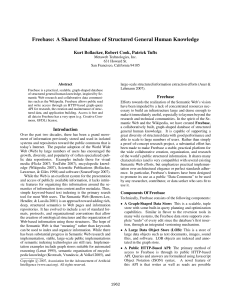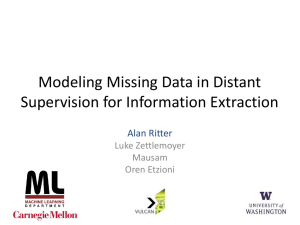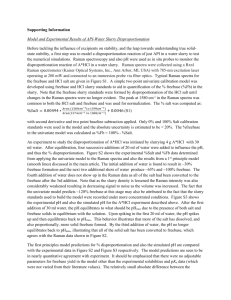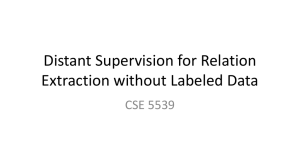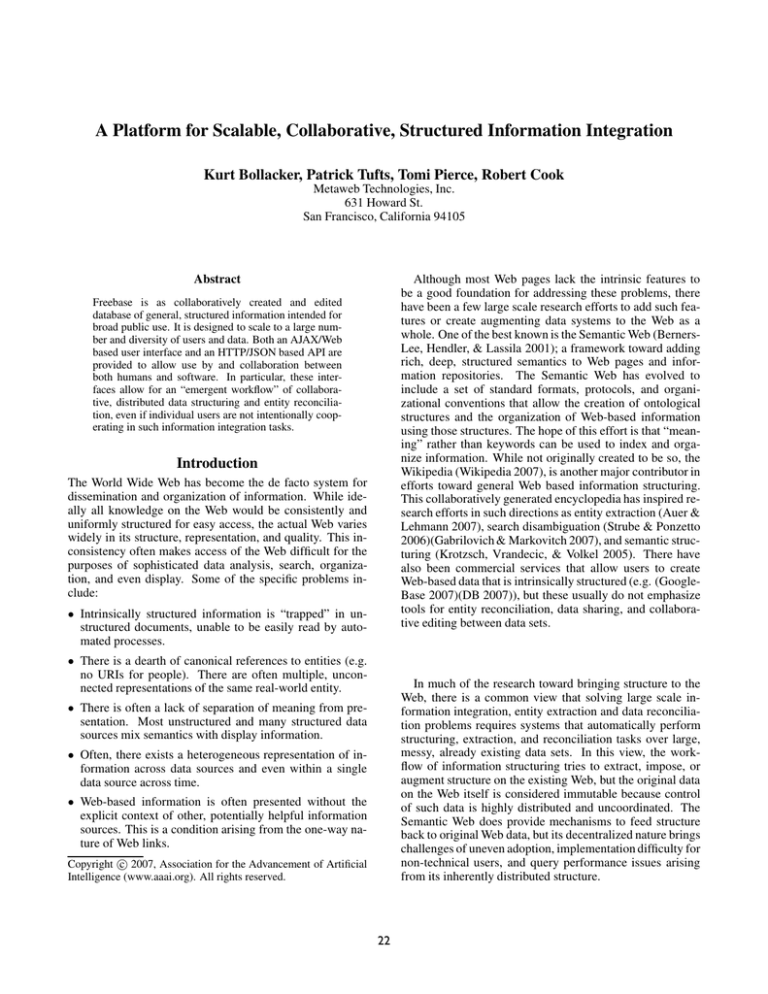
A Platform for Scalable, Collaborative, Structured Information Integration
Kurt Bollacker, Patrick Tufts, Tomi Pierce, Robert Cook
Metaweb Technologies, Inc.
631 Howard St.
San Francisco, California 94105
Although most Web pages lack the intrinsic features to
be a good foundation for addressing these problems, there
have been a few large scale research efforts to add such features or create augmenting data systems to the Web as a
whole. One of the best known is the Semantic Web (BernersLee, Hendler, & Lassila 2001); a framework toward adding
rich, deep, structured semantics to Web pages and information repositories. The Semantic Web has evolved to
include a set of standard formats, protocols, and organizational conventions that allow the creation of ontological
structures and the organization of Web-based information
using those structures. The hope of this effort is that “meaning” rather than keywords can be used to index and organize information. While not originally created to be so, the
Wikipedia (Wikipedia 2007), is another major contributor in
efforts toward general Web based information structuring.
This collaboratively generated encyclopedia has inspired research efforts in such directions as entity extraction (Auer &
Lehmann 2007), search disambiguation (Strube & Ponzetto
2006)(Gabrilovich & Markovitch 2007), and semantic structuring (Krotzsch, Vrandecic, & Volkel 2005). There have
also been commercial services that allow users to create
Web-based data that is intrinsically structured (e.g. (GoogleBase 2007)(DB 2007)), but these usually do not emphasize
tools for entity reconciliation, data sharing, and collaborative editing between data sets.
Abstract
Freebase is as collaboratively created and edited
database of general, structured information intended for
broad public use. It is designed to scale to a large number and diversity of users and data. Both an AJAX/Web
based user interface and an HTTP/JSON based API are
provided to allow use by and collaboration between
both humans and software. In particular, these interfaces allow for an “emergent workflow” of collaborative, distributed data structuring and entity reconciliation, even if individual users are not intentionally cooperating in such information integration tasks.
Introduction
The World Wide Web has become the de facto system for
dissemination and organization of information. While ideally all knowledge on the Web would be consistently and
uniformly structured for easy access, the actual Web varies
widely in its structure, representation, and quality. This inconsistency often makes access of the Web difficult for the
purposes of sophisticated data analysis, search, organization, and even display. Some of the specific problems include:
• Intrinsically structured information is “trapped” in unstructured documents, unable to be easily read by automated processes.
• There is a dearth of canonical references to entities (e.g.
no URIs for people). There are often multiple, unconnected representations of the same real-world entity.
In much of the research toward bringing structure to the
Web, there is a common view that solving large scale information integration, entity extraction and data reconciliation problems requires systems that automatically perform
structuring, extraction, and reconciliation tasks over large,
messy, already existing data sets. In this view, the workflow of information structuring tries to extract, impose, or
augment structure on the existing Web, but the original data
on the Web itself is considered immutable because control
of such data is highly distributed and uncoordinated. The
Semantic Web does provide mechanisms to feed structure
back to original Web data, but its decentralized nature brings
challenges of uneven adoption, implementation difficulty for
non-technical users, and query performance issues arising
from its inherently distributed structure.
• There is often a lack of separation of meaning from presentation. Most unstructured and many structured data
sources mix semantics with display information.
• Often, there exists a heterogeneous representation of information across data sources and even within a single
data source across time.
• Web-based information is often presented without the
explicit context of other, potentially helpful information
sources. This is a condition arising from the one-way nature of Web links.
c 2007, Association for the Advancement of Artificial
Copyright Intelligence (www.aaai.org). All rights reserved.
22
• An Easy-To-Use Web UI: Human users of Freebase can
use its Web interface (found at www.freebase.com) to
search, browse, edit, and organize data at a human scale.
This UI is AJAX-heavy and is intended to guide (especially non-technical) users toward structuring data and entity reconciliation by making these tasks as easy or easier than simple data entry. Novel features include typed
entity suggestion through an interactive auto-completion
mechanism, type-based filtering of search results, and
data cleaning at time of entry.
Freebase
Addressing some of the same large scale information integration problems that the Semantic Web and other similar
efforts, we have built Freebase, a collaborative database of
structured general human knowledge. The features of Freebase are designed to facilitate high “collaborative density”
among its users in the organization, representation, and integration of large, diverse data sets. In the abstraction of
Dataspaces (Franklin, Levy, & Maier 2005), Freebase may
be thought of as a DSSP with features to increase “Semantic Integration” while allowing a range of near and far “Administrative Proximity”. Freebase has an AJAX-based client
for human users and a JSON/HTTP-based API for machine
“users” so both can work together both tightly and asynchronously to create and edit complex, evolving, structured
data. Specifically, Freebase consists of the following components and features:
• A Substantial Seed Data Set: An emphasis has been
placed on on the early seeding of Freebase with data sets
of interest to the general population, rather than those that
are highly esoteric and specialized. This hopefully will
result in greater heterogeneity of structure and content,
that is more representative of the world’s sum of general
knowledge. The current data in Freebase consists of millions of concepts (topics) and tens of millions of relationships between those topics. Areas of initial seeding include popular culture (e.g. films, music, books, sports,
television), location information (restaurants, geolocations, businesses), scholarly information (linguistics, biology, astronomy), and general knowledge (Wikipedia).
While this data is already useful, we are making efforts
for it to grow quickly over time in both quantity and density of relationships.
• A Graph-Shaped Data Store: This is a scalable, tuple
store with some built-in query planning and optimization
capabilities, which allow deep, naively constructed, treeshaped queries to be satisfied quickly. This assists users
unskilled in query optimization in building high performing systems and algorithms using Freebase. Also, similar
in flavor to the reversion tools in many wiki systems, the
Freebase data store has an integrated versioning mechanism that supports complete reversion of all database edits, thus allowing “undo” of large, complex operations to
any degree. The graph store also supports fine-grained attribution of all data. Together, these two features allow
capabilities such as fixing damage caused by malicious
and/or defective users and algorithms.
• A Creative Commons License: One of the problems
with using and redistributing data on the Web is the restrictions and ambiguity of the copyright on that data. To
avoid this problem in Freebase, by default and with few
exceptions, all users who contribute to Freebase agree to
a Creative Commons Attribution (CC-by) license(Berry &
Moss 2005) for their data.
• A Large Data Object Store (LOB): This is a store of
large data objects such as text documents, images, sound
files, and software. LOB objects are indexed and annotated in the graph store, and are accessed through the same
API as the graph store.
• A Lightweight Typing System: Pervasive in the UI, API,
and data itself is the Freebase typing system. It is a
loose collection of structuring mechanisms and conventions, rather than a rigid systems of ontologies and representations. The type system supports collaborative design
of types and properties, and there is no intrinsic canonical
world view of all knowledge. Conflicting and contradictory types and properties may exist simultaneously in order to reflect users differing opinions and understanding.
• A Public, HTTP-Based API: The primary method of
machine access to Freebase is through its public HTTPbased API. Queries and answers are formulated using the
“Metaweb Query Language” (MQL) that we have developed for this purpose, and which adheres to the Javascript
Object Notation (JSON) syntax (Flanagan 2007). A novel
feature of the Freebase API is that all writes as well as
reads are performed using MQL. MQL is “query by template” language designed for ease of use, and scalability on a graph store that is simultaneously being written
to and read from. This is a different focus than other,
more expressive (but traditionally read-only) graph/RDF
query languages (e.g. SPARQL,SeRQL,RQL). MQL is
well suited to use over continuously evolving, refactoring,
and updating data sets. Important MQL features include
mixing structural data matching with approximate string
matching of literals, cursors, and flat semantics of all
data, which makes mixing of data and metadata easy. Because of the intrinsic versioning of the graph store, MQL
also supports retrieval of data that has been deleted or replaced, through the use of appropriate filtering clauses.
The Type System in Freebase
The Freebase type system consists of very few moving parts.
Its features are designed to be simple and easily mapped
onto the ontological structures of other systems, consisting
of only the following kinds of objects:
• Topic: This is an object representing a discrete entity.
A topic may be specific and concrete, (e.g. Bill Clinton
or The City of Vancouver, Canada) or an abstract concept (e.g. The number PI, Zoroastrianism). In Freebase,
each topic is given exactly one globally unique identifier (GUID) which refers only that topic. While a topic
may have many names and may be used in many different
contexts in Freebase, each topic should represent one and
only one concept or entity in the world.
23
• Literal: A literal in Freebase is a simple scalar string, numeric value, boolean, or timestamp. All other data types
are built using explicit structure.
toes. The access features of Freebase are the Web UI for
interactive human use and the API for automated processes
and third party access applications.
Structure creation and information integration in Freebase
are intended to be a natural part of this usage of Freebase
rather than a task for which a specific user or agent must take
responsibility. It is expected that each user will do only as
much as is needed for his/her own purposes, but that collectively over time, the result will be overall increased and improved data structure. Unstructured data will become structured, errors will be fixed, and new, hopefully better, structure will be derived from old. The initial Freebase toolset
supports a number of features that are intended to create this
“emergent workflow” of integration, even if the users are not
explicitly trying to perform such integration.
• Type: A type is an object that is used to semantically
group topics. A topic associated with a type is considered
to be an instance of that type. Examples of types include
Film Actor, Person, Airport, and Programming Language.
Topics may have multiple types which may be added or
removed over time. (e.g. A person is elected president in
the USA may have the US President type added.) Like
a topic, a type represents exactly one meaning, even if
it has multiple names and usages. There is no notion of
a type hierarchy in Freebase. Instead, types are created
and “mixed in” as needed independently, because each
confers different expected properties. For example, “Film
Actor” does not inherit from “Person” because some actors may not be people (e.g. dogs, robots), but have the
same properties (e.g. Films, Film Awards) as human actors.
Adding Structure Interactively
Freebase’s AJAX-heavy, Web browser based user interface
is designed for data browsing, entry, and refactoring in the
context of many other users performing similar actions. All
write operations are immediately visible, making tightly interactive data entry and structure creation possible. Some
workflow examples of Freebase usage through the UI that
result in information integration include:
• Property: A property can be thought of as a flavor of attribute of a topic in Freebase. Properties may be literals
(e.g. a name, a length, a SKU number) or relationships
to another topic (e.g. is a parent of, is contained by, has
sequel). A topic using a property is considered to have
an instance of that property. Every property has an “Expected Type”, which is an indicator that the topic at other
end of the property’s link is likely to be of the expected
type.
• Creation and editing of types and properties: As an example, Figure 1 shows a user editing the schema for the
“Medicinal Plant” type. Here the expected type for the
“Condition Treated” property is being set to “Disease”.
Notice how the auto-completion suggests “Disease” as
a choice, including a description of what the type itself.
This highly contextual display of information is one of
the key interactive features that reduces the creation of redundant entities and thus helps the reconciliation process.
• Creating and editing structured instance information:
Users can create new entities (topics), give these entities
types, and create property instances that are part of the
schemas of those types. Figure 2 shows a user adding
a “Condition Treated” relationship from the Medicinal
Plant topic “Dandelion”. Auto-completion suggests the
match of “Dyspepsia” to the user. The user may also create a new entity with the desired name. In either case, the
entity at the end of this link is automatically typed with
the expected type if needed. This is an example of how
the Freebase Web UI extracts information from the user
implicit intention to add to the overall explicit structure of
the data without burdening the user with extra effort.
• Marking topics for reconciliation and cleaning: Unlike in some databases, entities in Freebase are intended
to be explicitly canonicalized. That is, there should
be only one GUID in Freebase representing each real
world entity, topic, or concept. Entity canonicalization
in Freebase is organized as topic reconciliation through
a “mark and sweep” process. Using the Web UI, users
can mark a topic as a suggestion for future processing of
that topic. For example, a user can mark a topic as being
a duplicate entity of another, creating a relationship between those topics having the meaning “should be merged
with”. Later, humans and/or algorithms can then “sweep”
• Schema: Each type has collection of zero or more properties, known as the schema of that type. If a topic is an
instance of a type, this is an indication that the properties
in the schema of that type are appropriate for application
to that topic. For example, if the topic Danny Hillis is an
instance of the type Person which has a schema with property Date of Birth, then it is expected that Danny Hillis
may have an instance of the Date of Birth property.
Rather than ontological correctness or logical consistency,
Freebase’s type system is designed for collaborative creation
of structure. Types and properties may be created by any
user to add structured data to topics in Freebase. As an example of collaborative workflow emerging from use of the
Freebase type system, differences of opinion can be explicitly represented as incompatible types and properties. One
user can create a property that asserts a specific positive relationship between two entities. If another user disagrees
and no compromise can be found, then this second user can
create a simultaneous property that asserts the negative relationship. Since all data in Freebase have fine grained attribution, third parties may simply filter query results by the
version of reality they wish to pay attention to.
Using Freebase To Create Structure
The use of Freebase is intended to be intrinsically collaborative between both human users and automated processes.
With a much finer grain of object than documents (as in
Wikipedia), users may more easily work on pieces of a complex data set without accidentally stepping on each other’s
24
Figure 1: A screenshot of a user editing property in a type schema.
through these marks to actually perform the merges. This
process thus allows for users who have insufficient permissions to perform a merge to request one. Also, multiple users/algorithms may mark the merge, thus allowing
a form of voting on an operation for controversial operations. This mark and sweep process can also be used
to mark entities for deletion (e.g. spam or copyright violations) or for other gardening tasks as the need arises.
Since the users can create their own types and properties,
they can create their own set of mark relationships and
their own sweep processes. Figure 3 shows a user marking a musical artist topic for merge with another topic
about the same artist (but was spelled differently).
"query":[{
"album":[],
"name":"The Police",
"type":"/music/artist"
}]
}
asks for the albums of a musical artist. The result is the same
shape as the query:
{
"q1": {
"status": "/mql/status/ok",
"result": [
{
"album": [
"Outlandos d’Amour",
"Reggatta de Blanc",
"Zenyatta Mondatta",
"Ghost in the Machine",
"Synchronicity",
"Every Breath You Take:
The Singles",
"Greatest Hits",
"Every Breath You Take:
The Classics",
"Their Greatest Hits",
"Can’t Stand Losing You",
"Roxanne ’97"
],
"type": "/music/artist",
Using The Freebase API
While our efforts so far have been focused on collaborative
features in Its Web-based user interface, Freebase also has
an API that supports highly expressive structured queries.
Through the API, MQL queries in JSON syntax are submitted via HTTP with responses returned also in JSON. MQL
is best thought of as a “query by template” language in that
the shape of the MQL query result is defined by the shape of
the query, excepting the cardinality of (sub)results and some
administrative directives. We chose JSON to represent our
query results rather than the standard RDF due to the greater
ease in building Web application using JSON. We hope to
have an RDF export facility in the near future.
A simple example of a MQL query:
{
25
Figure 2: A screenshot of a user creating a link between entities.
Figure 3: A screenshot of a user marking two topics as duplicates to be merged.
"name": "The Police"
{
}
"q1": {
"status": "/mql/status/ok",
"result": [
{
"type": "/type/type",
"id": "/music/artist",
"properties": [
"/music/artist/origin",
"/music/artist/active_start",
"/music/artist/active_end",
"/music/artist/genre",
"/music/artist/label",
"/music/artist/home_page",
"/music/artist/member",
"/music/artist/album",
"/music/artist/contribution",
"/music/artist/track",
]
},
"status": "200 OK"
}
MQL’s type system is considered to be plain data like any
other in Freebase. A query asking for the properties of the
“Musical Artist” type would look like:
{
"query":[{
"id":"/music/artist",
"properties":[],
"type":"/type/type"
}]
}
Freebase would give the result:
26
Gabrilovich, E., and Markovitch, S. 2007. Computing semantic relatedness using wikipedia-based explicit semantic analysis. In Proceedings of the 20th International Joint
Conference on Artificial Intelligence.
GoogleBase.
2007.
Googebase. [on the internet.
http://base.google.com].
Krotzsch, M.; Vrandecic, D.; and Volkel, M. 2005.
”wikipedia and the semantic web - the missing links”. In
Proceedings of Wikimania 2005, Frankfurt, Germany.
Strube, M., and Ponzetto, S. P. 2006. WikiRelate! computing semantic relatedness using wikipedia. In Proceedings
of the Association For the Advancement of Artificial Intelligence.
Wikipedia. 2007. Wikipedia: The free encyclopedia. [on
the internet. http://www.wikipedia.org].
]
}
]
},
"status": "200 OK"
}
The Freebase Web UI runs entirely in the user’s browser,
accessing Freebase through its API, as any other client application would. The existence of the Web UI demonstrates
some of the capabilities that Freebase applications can have.
Summary and Future Work
The Freebase service is being built as a practical platform
for collaborative creation and evolution of structured data.
The Freebase Web UI and API support a number of interactive workflows that allow personal needs to result in adding
globally usable structure that can be immediately used by
others.
We are offering Freebase as a free public service to all
users and have built a Web UI that facilitates the structuring
of data and reconciliation of entities. However, as of the time
of this paper, we are still in an “alpha” testing phase. Readers interested in participating in this phase are encouraged
to contact the authors or visit www.freebase.com to request an account. We will continue to improve Freebase by
adding data and user interface features, but we recognize that
there is still much work to be done. We hope that increased
usage will progress Freebase toward becoming a “structured
data commons” for much of the world’s public data. We encourage those who are interested in building public data services that access the data in Freebase to create applications
and holders of sharable data sets that may be of public interest to include them in Freebase. Researchers in areas such as
entity extraction and reconciliation, data mining, Semantic
Web, information retrieval, ontology creation and analysis,
and graph analysis can use the Freebase API to support their
work.
References
Auer, S., and Lehmann, J. 2007. ”what have innsbruck
and leipzig in common? extracting semantics from wiki
content”. In Proceedings of the European Semantic Web
Conference (TO BE PUBLISHED).
Berners-Lee, T.; Hendler, J.; and Lassila, O. 2001. ”the
semantic web”. Scientific American 284:34–43.
Berry, D. M., and Moss, G. 2005. ”the libre culture manifesto”.
DB, D. 2007. The dabble db database creation service. [on
the internet. http://www.dabbledb.com].
Flanagan, D.
2007.
Developing Metaweb-Enabled
Web Applications.
Metaweb Technologies, Inc.
www.freebase.com.
Franklin, M.; Levy, A.; and Maier, D. 2005. From
databases to dataspaces: A new abstraction for information
management.
27

